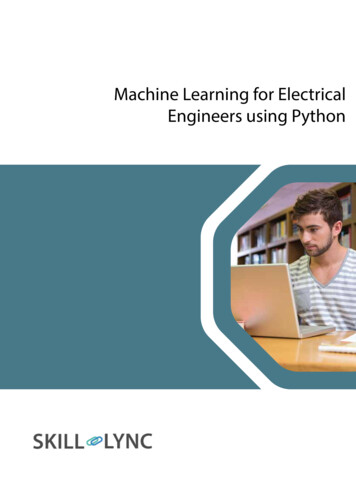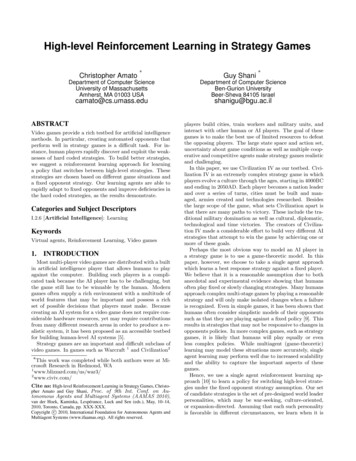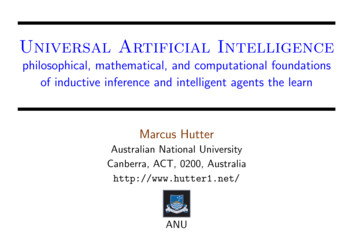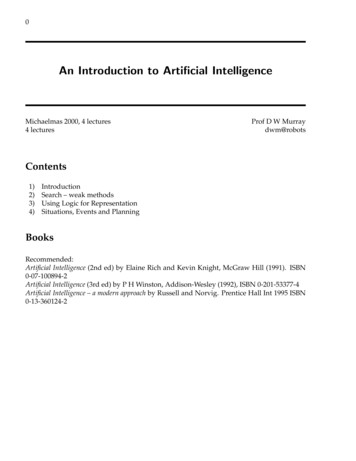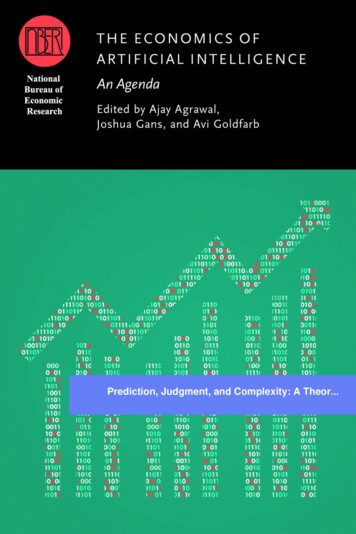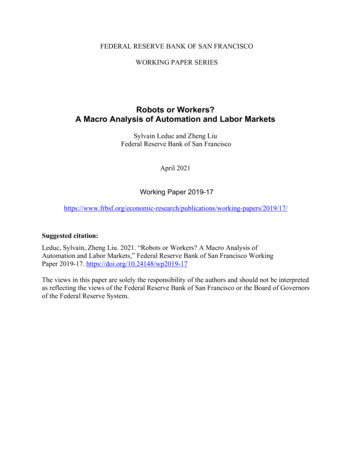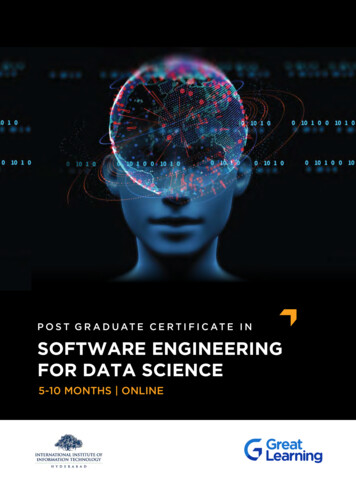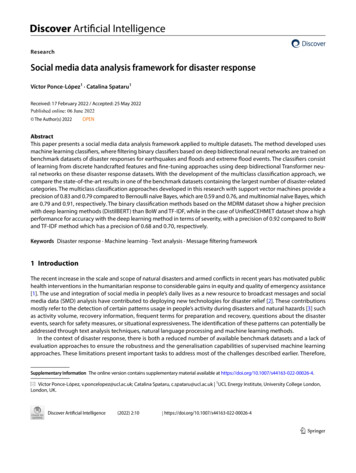
Transcription
Discover Artificial IntelligenceResearchSocial media data analysis framework for disaster responseVíctor Ponce‑López1 · Catalina Spataru1Received: 17 February 2022 / Accepted: 25 May 2022 The Author(s) 2022 OPENAbstractThis paper presents a social media data analysis framework applied to multiple datasets. The method developed usesmachine learning classifiers, where filtering binary classifiers based on deep bidirectional neural networks are trained onbenchmark datasets of disaster responses for earthquakes and floods and extreme flood events. The classifiers consistof learning from discrete handcrafted features and fine-tuning approaches using deep bidirectional Transformer neural networks on these disaster response datasets. With the development of the multiclass classification approach, wecompare the state-of-the-art results in one of the benchmark datasets containing the largest number of disaster-relatedcategories. The multiclass classification approaches developed in this research with support vector machines provide aprecision of 0.83 and 0.79 compared to Bernoulli naïve Bayes, which are 0.59 and 0.76, and multinomial naïve Bayes, whichare 0.79 and 0.91, respectively. The binary classification methods based on the MDRM dataset show a higher precisionwith deep learning methods (DistilBERT) than BoW and TF-IDF, while in the case of UnifiedCEHMET dataset show a highperformance for accuracy with the deep learning method in terms of severity, with a precision of 0.92 compared to BoWand TF-IDF method which has a precision of 0.68 and 0.70, respectively.Keywords Disaster response · Machine learning · Text analysis · Message filtering framework1 IntroductionThe recent increase in the scale and scope of natural disasters and armed conflicts in recent years has motivated publichealth interventions in the humanitarian response to considerable gains in equity and quality of emergency assistance[1]. The use and integration of social media in people’s daily lives as a new resource to broadcast messages and socialmedia data (SMD) analysis have contributed to deploying new technologies for disaster relief [2]. These contributionsmostly refer to the detection of certain patterns usage in people’s activity during disasters and natural hazards [3] suchas activity volume, recovery information, frequent terms for preparation and recovery, questions about the disasterevents, search for safety measures, or situational expressiveness. The identification of these patterns can potentially beaddressed through text analysis techniques, natural language processing and machine learning methods.In the context of disaster response, there is both a reduced number of available benchmark datasets and a lack ofevaluation approaches to ensure the robustness and the generalisation capabilities of supervised machine learningapproaches. These limitations present important tasks to address most of the challenges described earlier. Therefore,Supplementary Information The online version contains supplementary material available at https:// doi. org/ 10. 1007/ s44163- 022- 00026-4.* Víctor Ponce‑López, v.poncelopez@ucl.ac.uk; Catalina Spataru, c.spataru@ucl.ac.uk 1UCL Energy Institute, University College London,London, UK.Discover Artificial Intelligence(2022) 2:10 0123456789)
ResearchDiscover Artificial Intelligence(2022) 2:10 https://doi.org/10.1007/s44163-022-00026-4further research and development of frameworks become a need to effectively train meaningful and robust models.Indeed, this is a crucial step (1) to filter the massive-unconstrained textual information from SMD collections and (2) toinform automatically about certain message categories which are relevant to the disaster domain. These are the twomain research challenges addressed in this work.In this paper, we present a filtering framework approach with its elements to extract raw messages from social mediadata and to detect those that belong to relevant disaster categories via machine learning classifiers. These classificationmodels are trained on benchmark datasets of disaster response and extreme events. We show a comparison of quantitative results for the different methods applied to these benchmark datasets with respect to existing works. We highlightthe novelty of this work in four key contributions:– We build a new classification model from benchmark datasets containing the largest number of multiple disasterrelated categories relevant to the disaster response domain. To the best of our knowledge, our model outperformstheir existing results on multiclass classification tasks.– We present new state-of-the-art results with the original form of the largest disaster-response dataset, in contrastto the current evaluations available. This is to provide with a more reliable validation strategy and results for futurecomparisons of machine learning approaches in the disaster domain.– We build several binary classifiers for the main disaster category groups using deep bidirectional neural networksof pretrained Transformer models, showing clear benefits in performance boost in comparison to traditional handcrafted feature models. We present a novel use of these deep learning approaches by fine-tuning pre-trained modelson these benchmark datasets. This procedure is also applied for the first time to train a deep learning classifier on alarge historic dataset of unified records from UK CEH (Centre for Ecology & Hydrology) [4] and MET (MeteorologicalOffice) [5], which describes extreme events with their multiple severity levels.– Finally, we present a web interface developed to illustrate the use of the framework with an example of applicationfor the different classification methods.This paper is organized as follows. Section 2 presents a summary of the most relevant tools for disaster response andtheir underlying APIs along with their main features and limitations. Bearing this in mind, we highlight the researchgap addressed in our proposed framework. In Sect. 3, we present our methodology for the data pre-processing and ourapproaches for model category learning. Sections 4 and 5 provide a concise description of the benchmark datasets usedto train our machine learning models and their evaluation, respectively. Moreover, in Sect. 5 we propose an extension ofthe evaluation approach for the multiclass classification approach to address a fundamental research gap to train robustmulticlass models for the purpose of disaster response. Section 6 describe the models utilised and the results obtained,followed by a discussion of the results presented with respect to the state-of-the-art in Sect. 7. Finally, we show an example of usage of our models with a developed web interface in Sect. 8. Section 9 concludes the paper.2 Literature survey of key tools and platforms for disaster responseThere exists a comprehensive list of tools, platforms, and tutorials1 for analysing social media data that are beyond thescope of this article. U.S. Department of Homeland Security (DHS) [6] provides an alphabetized list of them that includesproduct information.Although demographic data are some of the most common data collected worldwide, in the context of disasterresponse this type of data is not enough to assist affected populations and to guarantee their availability before, during or after disasters [7]. To address these issues, Poblet et al. [8] describe a high-level taxonomy to classify the differentplatforms and apps depending on the phase of the management disaster cycle, availability of the tool and its sourcecode, the main core functionalities, and crowdsourcing role types. Nevertheless, the variety of tools in the context ofdisaster response is considerably high. In this section, we refer to recent key tools suitable for natural disaster responsealong with their main scope, features, and limitations (Table 1).Due to the large number of studies in the literature of speciality, tools developed recently have been selected, andin line with the main features and scope of our framework, or those having functionalities that complement each other1https:// towar dsdat ascie nce. com/ how- to- build-a- real- time- twitt er- analy sis- using- big- data- tools- dd224 0946e 64.13Vol:.(1234567890)
ORA [35–37]Unspecified availability of twitter streaming.Uncertain information about versions, subscriptions, or availability of source code. Number ofnodes, agents and organisations is limited onthe ORA-LITE versionLimited to Twitter social media only. Unspecified availability of twitter streaming. Uncertaininformation about versions, subscriptions, oravailability of source code availability for module integrationLimited to Twitter social mediaRelies on WebSightLine. Uncertain integration.Only demo and free trial available. Oriented tofaster development towards product delivery.2–5 min real-time latency, 180-day historicalaccessLimited source code and uncertain moduleintegrationIn the new integrated Hootsuite platform, thereis a risk of missing early tweets from the streaming API being no longer retrievableWeb application limits the download to 50,000tweets per data collection. Specific-trustedtraining examples are required by the systemMain limitations(2022) 2:10TweetTracker [34]GNIP [33]/Twitter API EntreprisedSpinn3r [32] (DataStreamerc/Custom APIWebSightLineb/Custom APIAIDR [31]/Twitter API & Custom APICrisis communicationyourTwapperkeeper [30] (now in Hootsuitea)/Twitter APIMain featuresOpen Source, low-cost, simple, flexible andscalable. Retrieves content from search andstreaming APIsHumanitarian responseOpen Source. Multiple real-time filtering viageolocation, machine learning classification,and keyword-based. Training examples aredomain-customizableCustomizedMultiplatform. Full metadata and indexing.Duplicate detection. Add exclusion and customizable filtering on any fieldCustomizedMultiplatform. 95% of the data indexingrequirements in real-time streaming. Reducedcost, complexity and infrastructure on analysing unbounded text data. Easy and securedata stream integration. Machine learningmodels available and extensibleCustomizedFull stream available. Real-time and historicalsocial data available through data-drivendecisions. Insights to understand contentperformanceHumanitarian and Disaster ReliefFiltering based on keyword and location. Tracking according to hashtags, search terms, andlocation. Activity comparison across differenthashtags, search terms, and locations. Multiple metric visualisations for disaster preparedness and emerging disasters monitoring. Canbe paired with different analytical tools (e.g.ORA) to provide richer data insightsDynamic meta-network assessment Multiplatform. Joint network data importfrom Facebook accounts and email boxes.Hundreds of social network, dynamic networkand trail metrics, procedures for groupingnodes, local patterns identification, comparing and contrasting networks’ group contrast.Networks space–time change analysis. Dataconnection and location with geo-spatialnetwork metrics, and change detection techniques. Identification of key players, groupsand vulnerabilities. Model network changesover timeScopeTool / APITable 1 Description of tools for natural disaster responseDiscover Artificial Intelligence Vol.:(0123456789)13
Vol:.(1234567890)13https:// www. datas tream er. io/https:// websi ghtli ne. com/dhttps:// craft. co/https:// devel oper. twitt er. com/ en/ produ cts/ twitt er- api/ enter prisecbhttps:// www. hoots uite. com/Flexible and Scalable DisasterResponse SystemsSocial Radar also performs perception and sentiment analysisSocial Radar [38, 39], CRAFT, SORASCS [40, 41]aScopeTool / APITable 1 (continued)Main limitationsMultiplatform. Interoperation to create flexible Social Radar and CRAFT do not provide facilitiesto preserve particular workflows for future use.disaster response systems and scalable dataSORASCS is at a different level of applicationstorage systems that support social mediahierarchy than CRAFT and Social Radar: the usercollection and analysis. Specific workflows’is responsible for supplying a database compreservation, sharing, and modification. Webponent themselves. SORASCS has weaker userbased system chaining together third-partyinterfaces from a crisis responder’s perspectivetools for sequential data analyses. Interfacesfrom a crisis responder’s perspective. It can beused as components of larger workflowsMain featuresResearchDiscover Artificial Intelligence(2022) 2:10 https://doi.org/10.1007/s44163-022-00026-4
Discover Artificial Intelligence(2022) 2:10 Fig. 1 Schematic Diagram ofthe proposed Disaster Filtering Frameworkto address specific joint applications for disaster response. However, one may notice the literature does not provide aholistic framework for SMD supported by rigorous machine learning evaluations. In this paper, our goal is to addresssome of the key limitations on SMD analysis and evaluation modelling in a holistic manner, as the main contribution tothe state-of-the-art in artificial intelligence for the disaster domain.3 MethodologyIn this section, we present our proposed framework for the disaster filtering approach illustrated in Fig. 1. The data preprocessing is discussed in Sect. 3.1 as part of the data preparation module. Then, in Sect. 3.2, we present our modellingapproaches and category selection for binary and multilabel classification. We base on the principles from the Sphere’shumanitarian standards [9] to abstract higher-level categories of information needs into simpler categories that arerelevant to the disaster domain. This is described in detail as category mining in Sect. 3.2.3. We use the messages thatbelong to the original and simplified categories for training our multiclass and deep binary models, respectively. Theselearning approaches are supported by their evaluation discussed in Sect. 5 and model results in Sect. 6. Finally, theclassification examples are presented as part of a developed web application, which shows the steps of the frameworkarchitecture in Sect. 0.3.1 Preprocessing data for disaster response and text analysisFirst, we use a Twitter preprocessing library [10] for cleaning mentions, hashtags, smileys, emojis, or reserved words suchas RT; the BS4 library [11] to parse HTML URLs, and regular expression [12] operations in Python to remove anything thatis not a letter of a number in all the messages. Then, we prepare the data into training, validation and testing splits forthe learning process as explained in Sect. 5.In addition to the grouping strategy for some categories explained in Sect. 4.1, for the category ‘severity’, we treat withthe class imbalance problem by augmenting the minority subcategories via grouping moderate and severe events intoone single class and reducing the majority class by keeping the mild events into another class.3.2 Learning category modelsAfter preprocessing the data (Sect. 3.1), first we base on Naïve Bayes (NB) and Support Vector Classification (SVC)approaches for multiclass classification in one of the benchmark datasets with the largest number of disaster categories. Then, we build binary classifiers for different target categories based on traditional handcrafted features followedby the proposed fine-tuned DistilBERT deep learning models.13Vol.:(0123456789)
ResearchDiscover Artificial Intelligence(2022) 2:10 https://doi.org/10.1007/s44163-022-00026-43.2.1 Multiclass classificationOur multiclass classification approaches for comparison are based on naïve Bayes [13] methods and support vectormachines [14] for text classification. To build the models, we use [15] to implement the Pipeline and Grid Search techniques. The Pipeline consists of a structure that uses TF-IDF fractional counts from the encoded tokens. Then, Grid Searchis used to perform an exhaustive search over specified parameter values for the given estimators, including multinomialnaïve Bayes and support vector classification. We use these techniques to find the relevant parameters for these desiredmodels.3.2.2 Binary classification3.2.2.1 BoW and TF‑IDF We base on the approach from [16] to build binary classifiers for the different target categories based on traditional hand-crafted features: Bag of Words (BoW) and Term Frequency Inverse Document Frequency(TF-IDF). These two methods use the NTLK library [17] to perform tokenization by breaking the raw text into words,sentences called tokens, stop words removal filtering out noninformative words, and stemming by reducing a word toits word stem or lemma. The BoW method learns probabilistic models able to distinguish between the class of frequentterms appearing in the messages related to the target category and the class of those terms appearing in the rest of messages. The difference with respect to the TF-IDF method is that the TF-IDF learns probabilistic models able to compensate the BoW models by terms that appear in the inverse of the number of documents. Based on the approach providedin [16] to train these models for each target class, we then process the input test message into terms and classify it intothe class that gives a higher probability of its terms being present.3.2.2.2 DistilBERT Our deep binary classifier models are based on Distilled BERT [18], which stands for a distilled versionof BERT (Bidirectional Encoder Representations from Transformers [19]) and is 60% faster than BERT and 120% faster andsmaller than ELMo (Embeddings from Language Models [20]) and BiLSTM (Bidirectional Long-Short Term Memory [21])networks. DistilBERT is based on the compression technique known as knowledge distillation, from [22, 23], in which acompact learning model is trained to reproduce the behaviour of a larger learned model. These learning and learnedmodels are also called the student and the teacher, respectively, although they can consist of an ensemble of models. Insupervised machine learning, a model performing well on the training set will predict an output distribution with highprobability on the correct class and with near-zero probabilities on other classes. The knowledge distillation is based onthe idea that some of these ‘near-zero’ probabilities are larger than others and reflect, in part, the generalization capabilities of the model and how well it will perform on the test set.This lightweight version of BERT representations into DistilBERT models presents clear advantages in terms of speedingup their training processes without a noticeable lose of performance. It is particularly useful in practice when computational resources are limited, but also to ease transferability and reproducibility for both research and development ofapplications beyond the disaster domain.We use the Distilled BERT [18] method through the Python library Transformers [24]. This involves end-to-end tokenization, punctuation, splitting, and wordpiece based on the pre-trained BERT base-uncased model. Then, we fine-tune theDistilBERT model transformer with a sequence classification/regression head on top for General Language UnderstandingEvaluation (GLUE) tasks [25]. Overall, for these tasks DistilBERT has about half the total number of parameters of BERTbase and retains 95% of its performances. In our experiments, we set the maximum number of training epochs to 10for fine-tuning, and the number of global steps to evaluate and save the final models varies depending on the targetcategory for which the models are fine-tuned.3.2.3 Category miningThe multiclass classification approach utilises the multiple categories provided by the original datasets. On the otherhand, our binary classification approaches employ a strategy to abstract higher level categories in two datasets tofine-tune independent deep learning models. Our first deep model aims to distinguish disaster-related messages fromnondisaster-related messages. Then, we abstract categories for medical-related information formed by the categories ‘aidrelated’, ‘medical products’, ‘other aid’, ‘hospitals’, and ‘aid centres’ to fine-tune our second deep binary classifier. Similarly,another higher-level category group for information related to humanitarian standards is formed by the categories ‘medical help’, ‘water’, ‘food’, and ‘shelter’ to train another deep classification model. We apply this category mining approach13Vol:.(1234567890)
Discover Artificial Intelligence(2022) 2:10 to create these higher-level categories following the grouping criteria of information needs from Sphere’s humanitarianstandards [9]. Finally, we perform a similar strategy to fine-tune a deep binary classifier of flood events to distinguishmild flooding from moderate and severe flooding.4 DataIn this section, we specify the differences of all the data used in our analysis. First, we describe the annotated datasetswe use to learn models with our methodology for different target categories relevant to disaster and crisis management.The set of messages from annotated datasets is preprocessed at first glance using a similar procedure to that describedin Sect. 3.1.4.1 Annotated datasetsWe consider a set of annotated datasets to learn and evaluate our machine learning models via feature-based and deeplearning methods. To the best of our knowledge, this is the first time these datasets have been used and evaluated forpurposes related to crisis and disaster response. The following items describe the datasets:– The Social Media Disaster Tweets (SMDT) [26] dataset consists of 10,876 messages from Twitter. Each message wasannotated to distinguish between disaster-related and nondisaster-related messages. There are 4673 messages outof the total, which are labeled as related to disasters, and 6203 messages annotated as not relevant to disasters. Nodata splits are provided for evaluation.– The Multilingual Disaster Response Messages (MDRM) [27] dataset contains 30,000 messages drawn from eventsincluding an earthquake in Haiti in 2010, an earthquake in Chile in 2010, floods in Pakistan in 2010, superstormSandy in the U.S.A. in 2012, and news articles spanning many years and 100 s of different disasters. The data havebeen encoded with 34 different categories related to disaster response and have been stripped of messages withsensitive information in their entirety. Untranslated messages and their English translations are available, whichmake the dataset especially utile for text analytics and natural language processing (NLP) tasks and models. To thebest of our knowledge, this is the largest annotated dataset of disaster response messages. The data contain 20,316messages labelled as disaster-related, in which 2,158 are floods. Pre-stablished training, validation and testing splitsare provided for this dataset. We employ our category mining approach from Sect. 3.2.3 to identify 16,232 messagesrelated to medical information, and 9010 are related to humanitarian standards’ information.– The long-term dataset of unified records of extreme flooding events reported by the UK Centre for Ecology andHydrology (CEH) and the UK Meteorological Office (MET) between 1884 and 2013 [28]–from now abbreviated as‘UnifiedCEHMET’–is a unique dataset of 100 year records of flood events and their consequences on a national scale.Flood events were classified by severity based upon qualitative descriptions. The data were detrended for exposureusing population and dwelling house data. The adjusted record shows no trend in reported flooding over time, butthere is significant decade to decade variability. The dataset opens a new approach to considering flood occurrenceover a long-time scale using reported information. It contains a total of 1821 records with three impact categories ofmild, moderate, and severe events. From these total number of records, we found 661 records with descriptive messages—464 for mild events, 69 for moderate events, and 91 for severe events.5 Evaluation of machine learning modelsIn the case of the MDRM dataset, training, validation, and testing splits are provided by the dataset [27]. We use these provided splits to train our binary classifiers with handcrafted features and deep bidirectional Transformer neural networks.All splits are created ensuring a suitable balance ratio between positive and negative class samples for the different targetcategories ‘disaster’, ‘medical’, ‘humanitarian standards’, and ‘severity’, which are controlled by an empirically set parameter.However, for the multiclass classification approach, we use the entire MDRM dataset to perform the evaluation usingrandom splits of 33% for testing and 66% for training the models. Then, we train our classifiers using fivefold cross validation and compute the average scores for each metric. This is done to make results comparable with [29], given that all theresults we found for this dataset do not follow the proposed splits provided by the dataset on the multiclass classification13Vol.:(0123456789)
ResearchDiscover Artificial Intelligence(2022) 2:10 https://doi.org/10.1007/s44163-022-00026-4Fig. 2 Learning curve and scalability of the multiclass classification approaches (a) Bernoulli naïve Bayes, (b) multinomial naïve Bayes, and(c) support vector classification, using original splits of the MDRM datasettask. In addition, there is no information specified in those results about any validation strategy performed in theirevaluation, such as the k-fold cross validation which we do perform to provide with reliable results. We use this evaluation only for comparison purposes with existing reported results for this dataset. The performance of the SVC multiclassclassification approach with this strategy reach the training process after 8000 samples, with no further improvementsafter that point when adding more samples.Therefore, we perform an additional evaluation with the original form for the splits of the MDRM dataset to enhancecurrent results and to allow future research comparisons. To the best of our knowledge, there are no previously publishedresults for this dataset despite of the dataset being also publicly available with its original splits in competition platformssuch as Kaggle.2 Therefore, we provide for the first time a reliable machine learning evaluation for this dataset on thedisaster response domain. Figure 2 plots the learning curves to show the performance and scalability of our NB-basedapproaches and the SVC multiclass classification approach. In this case, the improvement is progressively slower duringthe training process as we add more samples until the point where the performance on the validation data is close to theperformance on the training data. This is due to the reduced number of validation samples in this setting of original splitsof the dataset with respect to the above setting using random splits. In this setting, we see a considerable improvementin the learning process in all our methods, especially in our SVC model. All models are trained using an Intel i7 CPU at2.60 GHz and 16 GB RAM. The SVC approach took 120 h to train the model.Since there are no splits provided for the other datasets, in all remaining settings, we generate the splits via randomsampling with 40% for testing and 60% for fine-tuning the binary classifiers. For the MDRM dataset, we fine-tuned eachdeep bidirectional Transformer neural network using an NVIDIA Tesla V100 GPU and 16 GB RAM, and the processes tookbetween 2 and 5 days depending on the category model. The severity model for the UnifiedCEHMET dataset contains aslightly less number of samples, and its deep bidirectional Transformer neural network was fine-tuned using an NVIDIAGeForce RTX 2060Ti and 16 GB RAM, and the process took 38 h.The results are provided in terms of precision, recall, F1-score, and binary classifier accuracy. Their values are between0 and 1 and higher is better. Note that we do not provide results for accuracy in test data in the multiclass classificationbecause when the class distribution is unbalanced, the accuracy metric is considered a poor choice, as it gives high scoresto that predict only the most frequent class.To calculate the above metrics we considered the method developed in [15]. These metrics are essentially defined forbinary classification tasks, which by default only the positive label is evaluated, assuming the positive class is labelled ‘1’.In extending a binary metric to multiclass or multilabel problems, the data are treated as a collection of binary problems,2https:// www. kaggle. com/ landl ord/ multi lingu al- disas ter- respo nse- messa ges.13Vol:.(1234567890)
Discover Artificial IntelligenceTable 2 Comparison ofmulticlass classificationmethods using random splitsTable 3 Comparison ofmulticlass classificationmethods using original splits(2022) 2:10 https://doi.org/10.1007/s44163-022-00026-4Micro Avg. scoresResearchMDRM datasetBernoulli NBMultinomial 610.830.570.67Micro Avg. scoresMDRM datasetBernoulli NBMultinomial NBSVC0.760.910.79Precisionone for each class. There are then several ways to average binary metric calculations across the set of classes, each ofwhich may be useful in some scenario. We select the ‘micro’ average parameter because gives each sample-class pair anequal contribution to the overall metric (because of sample-weight). Rather than summing the metric per class, this sumsthe dividends and divisors that make up the per-class metrics to calculate an overall quotient. Microaveraging may bepreferred in multilabel settings, including multiclass classification where a majority class is to be ignored.Therefore, we compute the micro-Average Precision (mAP) from prediction scores as: ()mAP Rn Rn 1 Pn(1)nwhere Pn and Rn are the precision and recall at the n-th threshold and
large historic dataset of unied records from UK CEH (Centre for Ecology & Hydrology) [4] and MET (Meteorological Oce) [5 ], which describes extreme events with their multiple severity levels. - Finally, we present a web interface developed to illustrate the use of the framework with an example of application for the dierent classication methods.
